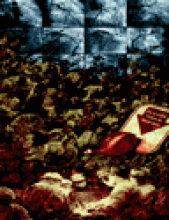- © 2004 Canadian Medical Association or its licensors
With new technologies in micro-surgery and antirejection drugs, facial transplantation is now technically possible, but British surgeons are being urged to hold off until the ethical issues are debated and more research into immunotherapy and psychological risks is conducted

Figure. From sci-fi to reality: Die Another Day henchman Zao (played by Rick Yune) in mid-transplant. Photo by: MGM Studios Inc.
The procedure is “highly experimental” and “appears to be very hazardous,” concludes a new report from the Royal College of Surgeons of England. The report also acknowledges that the treatment would “constitute a major breakthrough in restoration of quality of life to those whose faces have been destroyed by accident or tumour. Our conclusion does not underestimate the suffering of those patients who might be tempted by the prospect.”
Physicians in the US, UK and France say they are ready to do face transplants. The American and French teams are awaiting regulatory approval for the procedure.
Facial transplants involve removing facial muscles and skin from a cadaveric donor and placing them on a living person. They do not result in the recipient looking like the donor, however, the change in appearance can give rise to psychological issues surrounding identity.
Plastic surgeons view face transplants as an advancement over reconstructive surgery, which results in a mask-like appearance. Transplants provide some movement and sensitivity, allowing the patients to convey feelings and smile.
Dr. Peter Butler is the consultant plastic surgeon at London's Royal Free Hospital whose claim last year that 10 people had requested facial transplantation sparked the convening of the College's working party. He now says that it would be unwise at present to proceed. “From a surgical point of view we're ready. We've worked out what an ideal patient would be,” he told CMAJ. “But we agree that the psychological impacts and the issue of immunosuppression still need to be debated” before any procedure takes place.
“For facial transplantation to take place before this is done would be a step backwards rather than a step forward.”
All transplant recipients require a lifetime of immunosuppressive drugs, which may shorten life-span. Dr. James Partridge, founder and chief executive of Changing Faces, a charity that helps people with facial disfigurement, wonders if this risk is appropriate for a procedure that does not preserve or prolong life. “We must be very clear about the side effects of the immunosuppression drugs before we proceed.”
Psychologically, the disruption to the recipient's facial appearance and their concept of self-identity may result in a major life crisis, particularly in those with unrealistic expectations. “What would it mean for a person to have a different face?” asked Partridge, who emphasizes the need for more research and debate.
One of the problems, Butler said, is that “we really won't know the full impact until we do it on a human being.”
The college report concludes that: “It also remains unclear how acceptable and valid consent can be obtained from potential recipients, given the uncertainties about the risks and benefits .”
Butler, who rejected the suggestion that a “race for the face” had developed between his group and the 2 Kentucky-based teams, concedes that because of resources and infrastructure “the American group is probably the closest.” In fact, he stated that “they are already assessing patients for facial transplantations.”
The Royal College of Surgeons of England welcomes comments on its Facial Transplantation: Working Party report (www.rcseng.ac.uk) until Feb. 27. — Jocalyn Clark, London, UK











